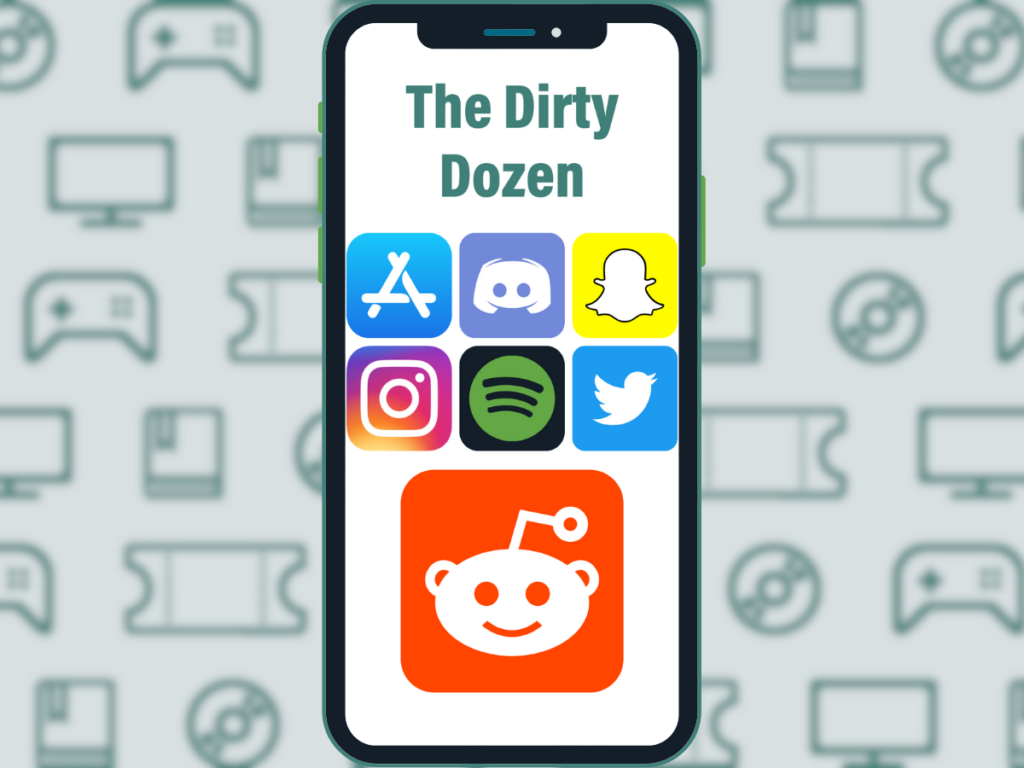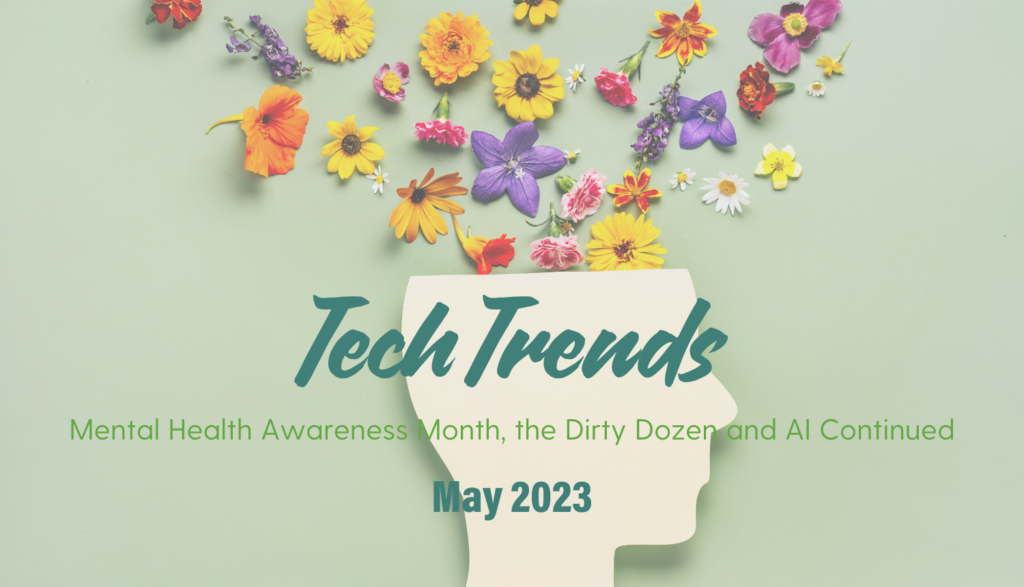Each month, Plugged In will release a blog with the latest technology and social media trends. We’ll let you know what changes to keep an eye out for. We’ll offer some tips about how to handle technology in your family. And of course, we’ll give you the scoop on those things called “hashtags” so you can stay up to date on all the things your kids might be obsessed with.
And ICYMI (“in case you missed it,” for those up on their social acronyms), you can check out April’s Tech Trends, too.

How Technology Affects Mental Health
May is Mental Health Awareness Month. And as such, we’d like to touch on how technology and social media might be affecting your and your kids’ mental health.
A recent report from the Centers for Disease Control and Prevention showed “almost 60% of U.S. girls reported persistent sadness and hopelessness,” says Fox News. It showed that rates are up in boys, as well, but only about half as many are affected.
Many reasons were cited for these mental health problems: pressure to perform well in school, fear of sexual violence and, as you might have guessed, the superficiality of social media.
Study Finds reported that habitual users “exhibit higher levels of loneliness, anxiety, and depression,” particularly for those watching content about other people’s lives. And these parasocial relationships may be a cause for concern since they can take priority over real relationships, resulting in that feeling of loneliness.
But the technology that makes social media so accessible is part of the problem, too. Lately, a growing number of Gen Zers have been ditching their smartphones for ‘dumb phones,’ aka the flip phones of the early 2000s. And while part of this is due to the nostalgia of having a “vintage” phone (yes, I cringe at that since my childhood is now considered vintage), it also allows for a digital detox.
Instead of being constantly harassed by emails, Instagram updates and Facebook messages (not to mention the pressure to respond instantly) The Wall Street Journal reports that flip phone users are able to detach from “constant notifications and the lure of infinite scroll, without losing the ability to send texts and make calls in an emergency.”
Experts have also reported that it isn’t so much about the quantity of “screen time” your child has but rather the quality. “Too much time on a phone matters mainly if it is at the cost of parent-child interactions—the most important thing of all—along with children getting sufficient sleep and physical exercise,” Sonia Livingstone, a professor social psychology at the London School of Economics, told the Guardian. “If children are doing homework, watching an educational app, chatting with a grandparent, dancing in front of a music video, playing a game with a sibling, there is no evidence that any of this is a problem, and some evidence that it’s a benefit.”
But if controlling the smartphone experiences doesn’t feel like enough, you can always go “off the grid” this month (much like the outdoor clothier, L.L. Bean, which wiped its Instagram account clean in support of Mental Health Awareness Month to encourage families to spend more time outside and less time online).

What Is the Dirty Dozen List?
According to the National Center on Sexual Exploitation, “The Dirty Dozen List is an annual campaign calling out twelve mainstream entities for facilitating, enabling, and even profiting from sexual abuse and exploitation.” It encourages parents to appeal for policy changes that will stop these apps and websites from endangering children and teens.
But for those who simply want to know what apps to avoid (or maybe just monitor a little more closely), here’s the list, along with some brief descriptions of their problems:
- Apple App Store: “Apple App Store age ratings and descriptions mislead parents about the content, risks, and dangers to children on available apps.”
- Discord: “This messaging platform is popular with predators who want to groom children and find and trade child sexual abuse materials.”
- eBay: Items available for sale include “childlike sex abuse dolls and spycams advertised specifically for filming women without their consent.”
- Instagram: “Grooming, child sexual abuse materials, sex trafficking, and many other harms continue to fester on Instagram.”
- Kik: “The anonymous messaging app is a ‘predator’s paradise’ for grooming kids and sharing images of their abuse, in addition to hardcore porn and prostitution ads.”
- Microsoft’s GitHub: “Deepfakes, ‘nudify’ apps, and AI-generated pornography originate on this collaboration platform for software development.”
- OnlyFans: “OnlyFans promotes itself as giving porn performers power, but in reality it empowers sex traffickers, child exploiters, and ‘revenge porn’ posters.”
- Reddit: “This ‘front page of the Internet’ is a hub of child sexual abuse materials, sex trafficking, and image-based sexual abuse.”
- Roblox: “Among the blocks and buildings, kids may be exposed to predators and inappropriate content.”
- Snapchat: “Year after year, Snapchat is named a top spot for sextortion, sexual interactions between minors and adults, and pornography exposure.”
- Spotify: “Porn is too easy to spot on Spotify–and the parental controls are tone deaf.”
- Twitter: “Twitter was asked to take [child sexual abuse material] down and Twitter said, ‘We’ve looked at it and we’re not taking it down.’” —a judge at the U.S. 9th Circuit Court of Appeals.

AI Is Both a Blessing and a Curse (and Possibly Borg)
Yes, once again we are mentioning the rise of AI in our Tech Trends blog. Why? Because it doesn’t seem to be going away maybe ever. One of the latest headlines highlights the AI Index, an independent initiative at the Stanford Institute for Human-Centered Artificial Intelligence.
According to the report, AI can be quite helpful at times. It’s already been used to “aid hydrogen fusion, improve the efficiency of matrix manipulation, and generate new antibodies.” AI systems can also be used to optimize energy usage. And one company is even using AI to track coughing as a way of learning about (and helping to diagnose) respiratory diseases.
However, the study also shows that the technology has the potential for an untold number of problems. One writer for The Wall Street Journal demonstrated how AI cloning was able to fool her bank and her family. Law enforcement officials in Canada reported that one man used AI-generated voices cloned from social media profiles to con at least eight senior citizens out of $200,000 in just three days. (You can learn more about these AI spam calls in Plugged In’s blog “Voice Clones Are Ripping You Off.”)
Fox News reports that a new study by The Bulimia Project (a website that publishes content and research related to eating disorders) illustrates how AI-generated images show “unrealistic” body structures when asked to create images of the “perfect human body.”
Still others are concerned that AI will take over jobs. According to The Hollywood Reporter, the Writers Guild of America called for a strike that was at least partially related to studios’ alleged refusal to regulate AI writing in Hollywood. And since a study by PCMAG showed that only about half of Americans can differentiate the difference between AI and human writing, that’s not an entirely unbased fear.
We’re also seeing reports of how AI-generated images, videos and voice recordings are being used by other countries to spread propaganda by creating fake news anchors. The Atlantic reports how the use of AI-created images and videos could make social media even more toxic by causing users to question the validity of real videos or fall for the deepfaked ones. And dot.la reported on the different ways AI could be used to negatively affect the next presidential election.
But perhaps most telling thing about the future of AI was the resignation of Geoffrey Hinton (the “Godfather of AI” who won a 2018 Turing Award for pioneering some of the technology that now powers ChatGPT and other AI tools) from Google.
Hinton’s description of the difference between artificial intelligence and human intelligence is eerily similar to how the Borg of Star Trek operate: “With digital systems, you have many copies of the same set of weights, the same model of the world. All these copies can learn separately but share their knowledge instantly. So it’s as if you had 10,000 people and whenever one person learned something, everybody automatically knew it. And that’s how these chatbots can know so much more than any one person.”
According to The New York Times, Hinton left Google after more than a decade of service in order to “freely speak out about the risks of AI.” PCMAG writes that his immediate concern is the “spread of misinformation” mentioned above. However, he also says AI will replace jobs. And, worse still, he “fears machines will begin to exhibit unplanned behavior.”

#HashtagTrending
Hashtags, trends, reels, sounds, tracks, stories—we know it feels impossible to keep up with what the kids are into these days. But here’s a quick overview of what your teen might be posting/watching on TikTok, Instagram and all the other “socials” this month.
- “My Husband” (299.1K posts) – With Beyonce’s Renaissance tour going on, it’s not really surprising that a track using her voice is trending on TikTok.
- “Could You Be Loved” (133.2K posts) – Using this track by Bob Marley & The Wailers, folks are bringing “good vibes” to social media.
- “Fantasy” (100K posts) – What would happen if teens took Mariah Carey’s “Fantasy” and started strutting the streets? This trend, evidently.
- “Ok, Well That’s Interesting” (69.7K posts) – I find it interesting that people would rather share the assignments they’re trying to avoid than, you know, just doing them.
- “It’s Whack-a-doodle Time” (55.8K posts) – Users are taking this quote from Lisa Rinna to share things they think qualify as unhinged.
- “Wes Anderson” (36.8K posts) – Using this trending audio, contrasting colors and quirky clips, users are channeling the director Wes Anderson.
- “Still Don’t Know My Name” (32.1K posts) – Basically just a way to share cools images/videos of your travels.
- “Stolen Dance” (23.7K posts) – Milky Chance’s 2013 single, “Stolen Dance” is apparently making a comeback on Reels as Instagrammers use a sped-up version of the audio to recap vacation, a day in the life and morning routines.
- “Why Is Everyone Acting Weird” (18.5K posts) – Just in case you ever wanted to use Snookie’s voice to address the elephant in the room.
- “September” (16.5K posts) – Using the trending audio “September” by Sparky Deathcap (yes, you read that correctly), users share their upcoming summer vibes.
- “If This Is Your Vibe” (13K posts) – Choosing video clips that showcase your “brand” and then using the text tool to write, “If this is your vibe, I want to be friends.”
- “Never Too Much” (10K posts) – Because apparently there can never be too many “summer vibes” posts.
- “Sugar” (5K posts) – Taking Billie Holiday’s “Sugar” and pairing it with a GRWM (Get Ready With Me) post, day in the life vlog or a recipe.
- “Twelfth Street Rag” (3.8K posts) – Pairing a SpongeBob SquarePants audio clip with adorable animals.







3 Responses
-Technology can either be a good or bad thing depending on who is using it, how they are using it and what they are using it for.
-let’s not forget about those pesky AI shenanigans. AI cloning fooling banks and families? Fake news anchors created by AI? It’s like we’re living in a sci-fi movie but without the cool special effects. And Geoffrey Hinton, the “Godfather of AI,” leaving Google to warn us about the risks? It’s like a dramatic plot twist! Will machines start exhibiting unplanned behavior? Cue the suspenseful music!
But hey, amidst all the tech talk, it’s nice to see the Dirty Dozen list raising awareness about apps and websites that endanger children and teens. Kudos to National Walking Month, too! Let’s put on our hiking boots and walk our way to better mental health. Thanks!
-Man’s reach exceeding his grasp…
Jesus be with us…